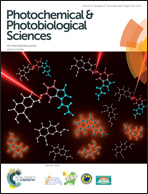Relay proton transfer triggered twisted intramolecular charge transfer†
Abstract
The mechanism for the dual emission of 2-(4′-N,N-dimethylaminophenyl)imidazo[4,5-c]pyridine (DMAPIP-c) in protic solvents was investigated by synthesizing and studying its analogues. Theoretical calculations were carried out to corroborate the experimental findings. The deprotonation studies suggest that the enhancement in the TICT emission of anionic forms of DMAPIP-c is limited to a protic environment. The spectral characteristics of DMAPIP-c were also studied in a methanol–acetonitrile binary solvent mixture. Unlike DMAPIP-c, the methyl derivatives do not emit dual fluorescence in protic solvents. The relative intensity of the TICT emission (with respect to that of normal emission) rises with the methanol amount in the acetonitrile–methanol binary solvent mixture. The studies also show that a 1 : 3 hydrogen bonded complex is formed between DMAPIP-c and methanol and it is responsible for the TICT emission. Based on the results a relay proton transfer tiggered TICT emission is proposed. TDDFT calculations were performed to predict the emission energies.


 Please wait while we load your content...
Please wait while we load your content...